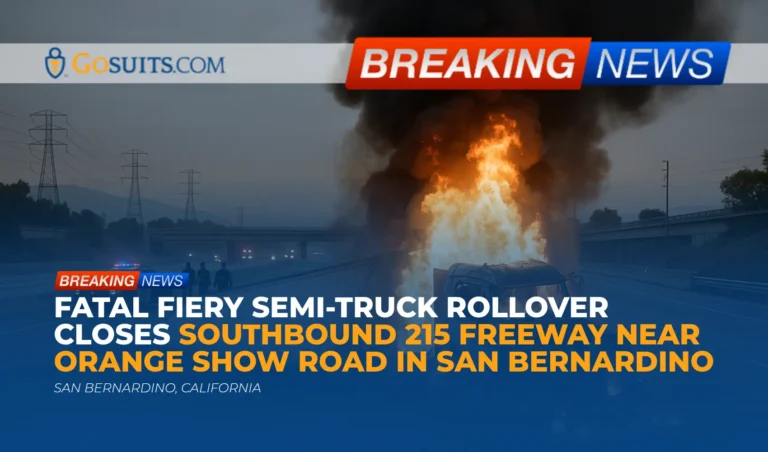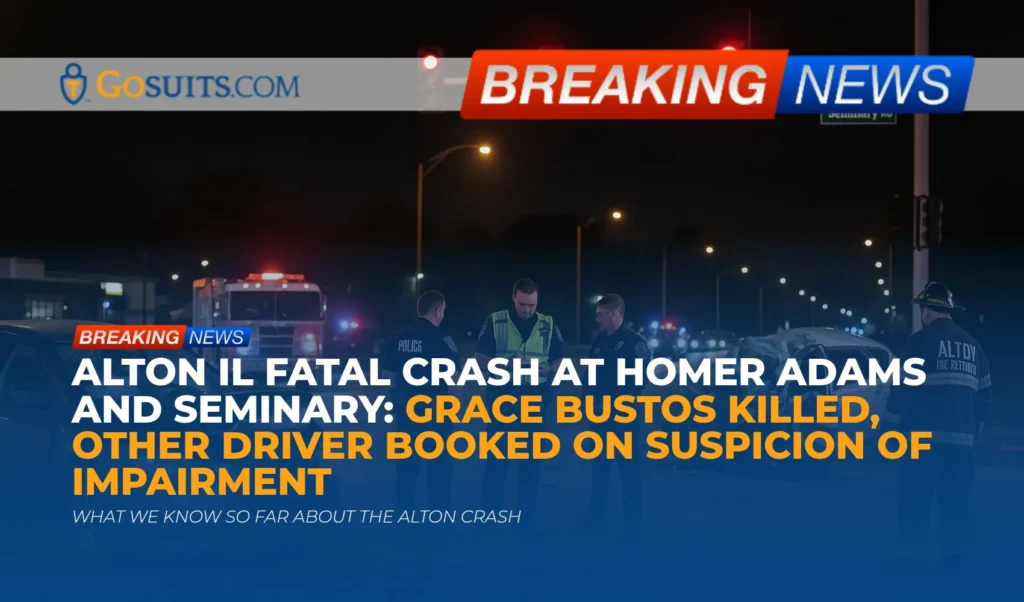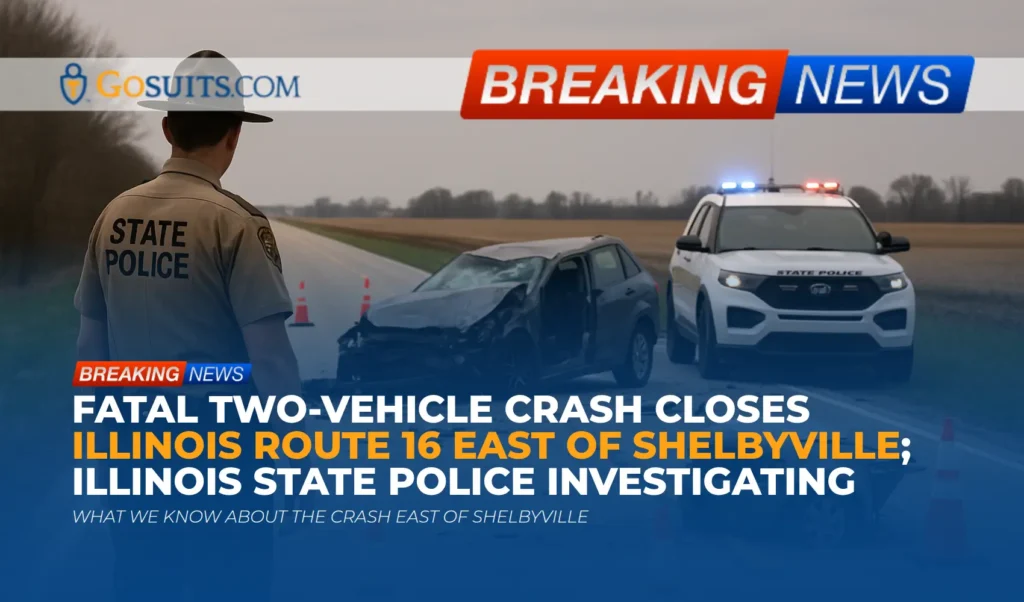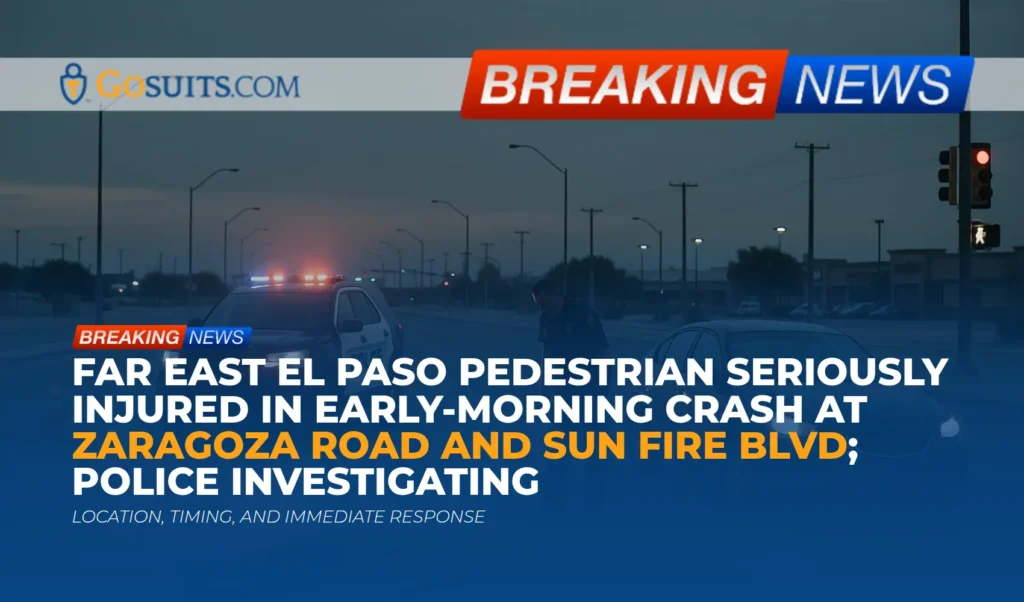- Summary of the crash
- What families and witnesses should do first
- How to obtain official records and reports
- Possible civil liability and legal issues (general overview)
- Insurance considerations after a commercial truck crash
- Evidence preservation and investigation sources
- Coroner, autopsy, and death certificate: what families should expect
- Common questions families ask after a fatal truck crash
- Helpful government resources and contacts
- Commentary from Gosuits San Bernardino, California Personal Injury Attorney
Summary of the crash
According to local reporting and preliminary statements from responding officers, a fatal collision occurred at approximately 2:00 a.m. on the southbound 215 Freeway near Orange Show Road in San Bernardino, California. A semi-truck hauling gravel reportedly lost control, struck a pole along the freeway shoulder, overturned, and caught fire with the driver still inside. Debris from the trailer was scattered across travel lanes. The driver was pronounced deceased at the scene.
California Highway Patrol (CHP) personnel closed southbound lanes under a SigAlert for several hours to conduct an on-scene investigation and clear the roadway. Investigators noted the trailer was registered to a local business. At the time of reporting, authorities had not publicly identified the driver or confirmed the driver’s base of operation.
In collisions like this, agencies commonly examine factors such as vehicle condition, loading and weight distribution, roadway conditions, and whether federal and state safety regulations were followed. Those determinations typically require time, technical documentation, and review of physical and electronic evidence.
What families and witnesses should do first
The immediate aftermath of a fatal crash is disorienting and painful. The steps below are general information to help community members understand typical actions taken after a serious incident. They are not a substitute for personalized counsel.
At the scene or shortly after
- Stay safe. Do not approach fire, leaking fuel, or unstable wreckage. Follow directions from first responders.
- Call 911 if hazards or injuries have not yet been reported. Early reporting helps responders secure the scene and protect others on the road.
- Preserve photos and videos. Keep original, time-stamped files taken at or near the scene. Avoid altering or enhancing them.
- Collect witness details if safe. Names, phone numbers, and brief statements can be important later.
In the hours and days following
- Contact the investigating agency. For freeway crashes in this area, CHP typically leads. Ask how and when a collision report can be requested, and which area office is handling the case. The CHP provides collision report guidance and area office contacts at chp.ca.gov.
- Reach the coroner or medical examiner. The San Bernardino County Sheriff-Coroner provides information about decedent release, autopsy, and report access for next of kin. See the county’s coroner information page at sbcounty.gov.
- Consider a consultation before insurer statements. Insurance adjusters or company representatives may call quickly. Recorded statements or signed forms can affect later civil claims. Speaking with a seasoned personal injury attorney first can help clarify rights and potential risks.
- Organize personal documents. Gather identification, relationship documents for next of kin, insurance policies, and any communications related to the incident.
How to obtain official records and reports
Official documentation helps families understand what happened and, when appropriate, support civil claims. Processing times vary by agency and by the complexity of the investigation.
CHP collision report
- Where to request. Collision reports are generally requested from the CHP area office that investigated the crash. Guidance and the CHP request process (including the CHP 190 form) are provided at chp.ca.gov. Area office locations can be found via the CHP’s office locator at chp.ca.gov.
- Who may request. CHP typically requires “party of interest” status, such as the involved driver, vehicle owner, or legal representative. Identification and applicable fees may be required.
- Timing. Reports can take days to several weeks, particularly when fatal or complex investigations are ongoing. Supplemental reports may follow as new information is developed.
Coroner/medical examiner and death certificate
- Autopsy and coroner’s report. Next of kin can contact the San Bernardino County Sheriff-Coroner for information about whether an autopsy was performed, cause and manner of death when available, and how to request copies. See sbcounty.gov.
- Death certificate. Death certificates in California are issued through county vital records and the California Department of Public Health. Background and state-level request information is available at the California Department of Public Health’s vital records page: cdph.ca.gov.
Other records
- 911 calls and dispatch records. Depending on retention policies and exemptions, audio and transcripts may be obtainable through a Public Records Act request to the agency or dispatch center. General information about the California Public Records Act is available from the California Attorney General at oag.ca.gov.
- Truck company and regulatory records. Maintenance logs, inspection records, driver qualification files, and electronic logging device (ELD) records are typically held by the motor carrier. These are often obtained in civil proceedings or through formal preservation requests. Federal hours-of-service and ELD information is available at the Federal Motor Carrier Safety Administration (FMCSA): fmcsa.dot.gov and fmcsa.dot.gov.
Possible civil liability and legal issues (general overview)
Commercial truck crashes can involve multiple parties and layered responsibilities. The points below are general areas that investigators and civil counsel often consider in fatal trucking collisions.
- Driver conduct. Loss of control may implicate speed, fatigue, distraction, or impairment. ELD data, phone records, and witness accounts can be relevant to reconstructing events.
- Motor carrier responsibility. An employing carrier can be responsible for its driver’s conduct under vicarious liability. Separate claims sometimes allege negligent hiring, training, supervision, or retention. These issues can turn on the driver’s record and company safety practices.
- Vehicle condition and maintenance. Brake systems, tires, steering, and coupling devices are critical to safe operation. Federal rules require systematic inspection, repair, and maintenance for commercial motor vehicles. See FMCSA Part 396 maintenance requirements at fmcsa.dot.gov.
- Loading and cargo securement. Gravel and other bulk materials must be properly loaded and secured to prevent shifting that can destabilize the trailer. FMCSA cargo securement guidance is available via fmcsa.dot.gov. Weight tickets, bills of lading, and load diagrams can be important evidence.
- Regulatory compliance and working hours. Hours-of-service rules are designed to reduce fatigue risk. Carrier compliance with recordkeeping and ELD requirements may bear on liability. See FMCSA hours-of-service overview at fmcsa.dot.gov.
- Roadway conditions and public entities. In some cases, road design, signage, or maintenance may be evaluated. Claims involving public agencies follow different procedures and strict timelines under California’s Government Claims Act. General state information on government claims is available from the Department of General Services at dgs.ca.gov.
- Third-party contractors. If a shipper, loader, or maintenance contractor contributed to unsafe conditions, those entities may be scrutinized for their role.

Insurance considerations after a commercial truck crash
Insurance in trucking matters can be complex, involving higher policy limits, multiple layers of coverage, and coordination with employers. Understanding the landscape helps families anticipate common issues.
Types of coverage commonly implicated
- Commercial auto liability. Carriers engaged in interstate commerce must meet minimum financial responsibility requirements. Federal minimums are set by regulation; see 49 CFR Part 387 via FMCSA at fmcsa.dot.gov. Actual policy limits may be higher.
- Motor carrier and shipper coverages. Depending on relationships, motor carriers may have general liability, cargo policies, or umbrella/excess coverage. Other potentially relevant coverage can include uninsured/underinsured motorist coverage for other vehicles involved.
- Workers’ compensation. If a driver was an employee acting within the course of employment, workers’ compensation issues can arise for dependents or the estate. These systems have separate procedures from civil wrongful death claims.
Communications with insurers
- Adjuster outreach. Insurers and company representatives often contact families quickly for statements or authorizations. Recorded or written statements and medical or employment releases can influence claim evaluation.
- Consider counsel before statements. It is generally prudent to speak with a knowledgeable attorney before providing recorded statements or signing releases. What is said to insurers may be referenced later.
Why acting promptly matters
This section provides general, non-directive information about timely action after a serious crash.
- Deadlines can be short. Civil claims are governed by statutes of limitation. Some claims involving public entities require formal notice within months. Waiting can limit available options.
- Evidence changes quickly. Vehicles are repaired or salvaged, skid marks fade, and digital data may be overwritten according to routine retention cycles. Early preservation efforts can protect critical information.
- Insurance positioning happens early. Carriers begin evaluating potential exposure immediately. Prompt, informed action can reduce the risk that early statements or documents will be used to narrow or deny claims.
- Clarity for the family. Understanding available benefits, such as workers’ compensation death benefits or life insurance, can help with immediate needs and final arrangements.
Evidence preservation and investigation sources
Commercial vehicle investigations often hinge on technical and time-sensitive evidence. Identifying and preserving key materials early can make a difference in understanding what happened.
- Official scene documentation. CHP photographs, diagrams, and measurements are central to reconstructing events. Requesting the full collision report and any supplements is an early priority. See chp.ca.gov.
- Truck and trailer data. Modern trucks may capture engine control module data, ELD logs, and GPS/telematics. FMCSA requires motor carriers to retain ELD records and supporting documents for at least six months. See fmcsa.dot.gov.
- Dash cameras and video. In-cab or outward-facing cameras, as well as nearby business or traffic cameras, can be pivotal. Many systems overwrite footage on a rolling basis unless preserved.
- Driver qualification and testing. Driver files may include licensing, training, medical certification, and drug and alcohol testing records. FMCSA regulations require specific recordkeeping by carriers; see fmcsa.dot.gov.
- Maintenance and inspection logs. Records showing brake, tire, and general maintenance, as well as pre- and post-trip inspections, can identify mechanical issues. FMCSA’s maintenance rules are in 49 CFR Part 396 at fmcsa.dot.gov.
- Loading documents. Bills of lading, weight tickets, and load diagrams help assess whether cargo weight and distribution contributed to loss of control.
- Physical components. Preserving damaged parts can facilitate expert examination for mechanical failure or defect.
Because key evidence may be controlled by the motor carrier or third parties, a written preservation request, sometimes called a spoliation hold, is often used in anticipation of a civil claim. Such a notice typically identifies categories of data and physical evidence to retain.
Coroner, autopsy, and death certificate: what families should expect
When a death occurs in a crash, the county coroner or medical examiner is usually involved. Understanding their role can help families know what to expect.
- Role of the coroner/ME. The coroner determines cause and manner of death and coordinates with law enforcement. For San Bernardino County, information about procedures and next-of-kin contacts is maintained by the Sheriff-Coroner at sbcounty.gov.
- Autopsy. Not every traffic fatality results in a full autopsy, but when performed, the report becomes part of the investigative record. Policies governing release vary; next of kin can request information on availability and timelines.
- Death certificate. Death certificates are issued through county or state vital records. The California Department of Public Health provides background on requesting certified copies at cdph.ca.gov. These documents are needed for insurance, benefits, estate matters, and funeral arrangements.
- Practical steps. Families commonly ask whether the decedent has been released to a funeral home, and how to request copies of reports. The coroner’s office can advise on identification procedures and next-of-kin documentation that may be required.
Common questions families ask after a fatal truck crash
The points below reflect common questions following a fatal collision. They are provided for general information.
- How long until the CHP collision report is available? Timeframes vary. Some reports are completed within days; others, especially those involving fatalities or complex circumstances, may take weeks or longer as investigators finalize findings and add supplements.
- Who pays for funeral expenses? Depending on circumstances, costs may be paid by the decedent’s estate, life insurance, certain employer benefits, or, in some cases, through civil claims or workers’ compensation death benefits. Providers can explain short-term options for advancing expenses while documents are pending.
- Should families speak directly with the trucking company or insurer? Company representatives may reach out quickly. Early statements and signed releases can affect later civil claims. Many families choose to consult an attorney first to understand implications before engaging with insurers.
- Are federal trucking rules relevant? Yes. Hours-of-service, ELD records, maintenance rules, and cargo securement standards can all bear on fault and safety compliance. See FMCSA at fmcsa.dot.gov.
- What if the roadway or a public agency contributed? Claims involving public entities follow special notice requirements and short deadlines under California’s Government Claims Act. General information is available from the Department of General Services at dgs.ca.gov.
- How common are large truck fatalities? National data show that crashes involving large trucks remain a significant safety concern. NHTSA publishes statistics and safety resources at nhtsa.gov.
- What if the driver was an independent contractor? Motor carrier responsibility may depend on federal and state law, contractual relationships, and control over operations. Investigations examine who directed the driver’s work, who maintained the vehicle, and how the hauling arrangement was structured.
- How long are 911 recordings kept? Retention periods vary by agency. Requests are often made promptly under the Public Records Act. See general PRA information from the Attorney General at oag.ca.gov.

Helpful government resources and contacts
The resources below provide authoritative information about collision reports, trucking regulations, safety data, and vital records in California.
- California Highway Patrol — collision report requests and area office contacts: chp.ca.gov and chp.ca.gov
- Federal Motor Carrier Safety Administration — hours-of-service, ELDs, maintenance, and insurance requirements: fmcsa.dot.gov
- National Highway Traffic Safety Administration — large truck crash data and safety resources: nhtsa.gov
- California Department of Public Health — death certificates and vital records: cdph.ca.gov
- San Bernardino County Sheriff-Coroner — decedent release and coroner information for the county: sbcounty.gov
- Caltrans — statewide traffic operations and incident information: dot.ca.gov
- California Attorney General — Public Records Act overview for requesting public records: oag.ca.gov
- California Department of General Services — Government Claims information for public entity claims: dgs.ca.gov
Commentary from Gosuits San Bernardino, California Personal Injury Attorney
Our hearts are with everyone affected by this tragic incident on the 215 near Orange Show Road. Losing a loved one in a commercial trucking crash is a profound loss, and the shock is compounded by the sudden arrival of complex procedures, insurance communications, and official reports. This commentary is shared for educational and general informational purposes.
From a civil perspective, a rollover and fire involving a gravel-hauling semi raise several lines of inquiry. Investigators and civil practitioners will often look closely at why control was lost, whether the cargo was properly loaded and secured, whether the vehicle’s braking and steering systems were in compliant condition, and whether the driver’s hours, rest, and recordkeeping met federal rules. It is also important to examine how the motor carrier screened, trained, and supervised the driver, and whether the company’s maintenance program followed required inspection and repair protocols. Each of these areas involves tangible records: ELD logs, GPS data, maintenance files, weight tickets, bills of lading, and company safety policies.
Insurance companies and corporate carriers typically mobilize quickly after a fatal crash. They may ask for recorded statements, request authorizations, or present early forms. Families often do not realize that what is said, or what is signed, can be cited later in evaluating or defending a claim. This is one reason why many people choose to speak with a seasoned and skilled personal injury attorney before engaging directly with insurers. A brief consultation can help clarify what information can be safely shared and what should be deferred until essential facts and records are secured.
Time matters. Some evidence, such as dash camera footage or telematics, can be overwritten on rolling cycles, and physical components may be scrapped or repaired. Agencies also have defined retention periods for 911 recordings and dispatch data. Early steps to preserve evidence can prevent the loss of critical details. There are also legal timelines to consider. Certain claims against public entities require notice within months, and wrongful death claims are governed by statutes of limitation that, if missed, can foreclose options. Understanding these timelines early helps families avoid unintended waivers of their rights.
Free initial consultations serve an important role in this period. They allow families to ask questions about reports, insurance communications, and preservation letters without committing to a course of action. They can provide clarity about next steps, how to request records from CHP and the coroner, and how to approach insurers in a way that does not inadvertently compromise a potential civil claim.
To anyone mourning a loss and trying to make sense of what comes next, please accept our sympathy. Taking measured, informed steps can protect both peace of mind and important rights while investigators continue their work.






